Thrustline Aerospace Mighty Mick
Thrustline Aerospace - Mighty Mick {Kit}
Contributed by Nick Esselman
| Manufacturer: | Thrustline Aerospace |
![[Picture]](/images/archive/images/ratings/rating_ta_mighty_mick.gif) (04/01/04) Thrustline Aerospace is a relatively new company
(opening in 2003). At first it seemed they were focused solely on OOP Estes
reproduction, however, they seem to be stretching out to their own designs.
This rocket, the Mighty Mick is a Thrustline original. I won it with my
Descon
12 entry.
(04/01/04) Thrustline Aerospace is a relatively new company
(opening in 2003). At first it seemed they were focused solely on OOP Estes
reproduction, however, they seem to be stretching out to their own designs.
This rocket, the Mighty Mick is a Thrustline original. I won it with my
Descon
12 entry.
Thrustline says this about the Mighty Mick, "Whenever you look at some of the larger rocket companies, it's really hard to find a... large tube, high performance rocket for sport rocketry that doesn't end up costing an arm and a leg! That's why I designed "Mighty Mick". I wanted a good solid looking rocket that I could put C11 through E motors in, without paying 30 dollars and up! This rocket has great flying flexibility!"

So, the Mighty Mick has a diameter of 1.64 inches and is 25 inches long and carries a price tag of about $14 (02/04). Some rockets that I feel are close equivalents include the Estes Eliminator (1.35" x 30.5"; $20.64) or the Estes Executioner (2.6" x 38.5", $37.50) and the FlisKits Rhino (1.6" x 24.5"; $11.95). The FlisKits Rhino isn't designed for E motors nor does it have a ripstop parachute, so it seems that Thrustline is correct on the pricing. What about performance and looks? Well, read on.
The kit includes a main body tube which is 1.64" x 17" and a solid balsa nose cone to make up the total length. The motor mount includes a 24mm tube that is 7" long, three (3) fiberboard centering rings, a motor hook and thrust ring designed for Estes E motor length. The recovery system includes a Kevlar® tether, an elastic shockcord, and 18" ripstop nylon parachute and an eye-screw to attach to the nose cone. There is a balsa sheet to cut out the three fins from and two launch lugs.
CONSTRUCTION:
The instructions are printed on 4 pages (single-sided) of 8½ x 11" paper. There are black-and-white photos throughout to assist in the assembly of the kit. There is also a single page with the fin template and tube marking guide (my kit was missing this, but Thrustline resolved that quickly). The rocket is very easy to build and is probably not much more than a level 2 kit.
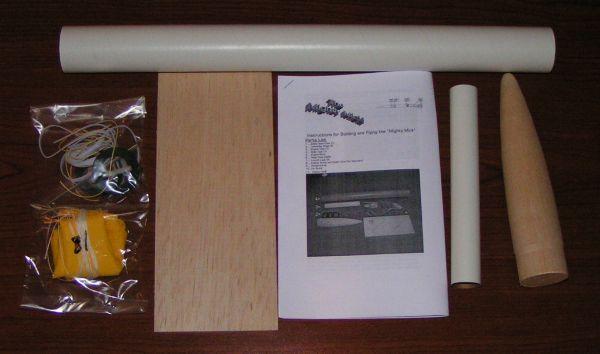
The motor tube is built first. After making 4 marks on the tube, for the insertion of the engine hook and the three centering rings assembly begins. The instructions are a bit confusing, but I think it is because of a typo I found. In step 1, it says that the marks at 1/4", 3-1/4", 3-1/2" and 6-3/4" are "...for the aft centering ring, the center centering ring, the rear engine clip insert point, and the forward centering ring respectively". However, in step 2 it says to "Make a 1/8th inch slit at the 3-1/4 inch mark" for the engine hook. After studying the drawings, I believed that step 2 should have said to make the slit at the 3-1/2 inch mark. But as I will explain later, I was wrong. Really, the mark at 3-1/4" is for both the rear engine clip insert and the center centering ring. Be real careful with this... in fact, here is a drawing for you. (Thrustline, please consider putting this in your instructions)
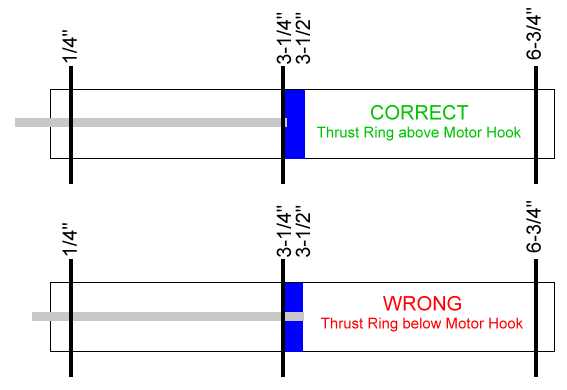
The Kevlar® tether is attached to the upper section of the motor tube. This is slid under the forward centering ring and secured. Nice arrangement. The motor tube assembly is put into the body tube. My assemble fit perfectly, however, Thrustline noted hat you may have to sand the fiber centering rings to get a good fit.
The fins are cut from the provided balsa using the fin template. Simple cuts. I choose to round my leading and trailing edges using sand paper prior to gluing the fins in place.
The rest of the construction is straightforward and basic build activity. Oh, I do want to mention that I built the entire rocket using Omni-Stick glue. I even did the fin fillets with this glue. It takes some getting used to, but grabs quickly (formerly called Quick Grab - see here for more info) and has adequate strength.
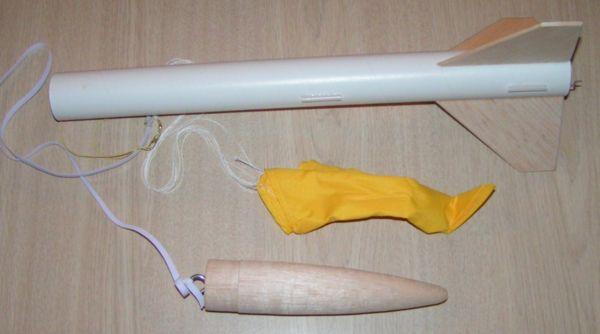
Thrustline does give finishing guidance including using wood filler, priming, sanding, priming, sanding, then painting. There are no decals provided with this kit.
Lastly, the parachute is assembled. This is done by pulling all the shroud lines together and cutting them so that they are even. Then tieing them on the provide swivel and placing some glue on the knot. No issues.
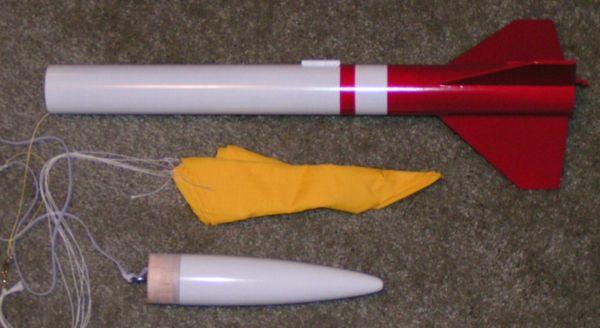
At first I wasn't thrilled about finishing this rocket and for those that have followed my reviews, it is my least favorite part of building. As I continued to look at this rocket, I really started to appreciate the "classic" lines with the 3-fin and nose cone design. That appreciation led me to putting forth great effort to finish it. So after many, many coats of Plastic-Kote Primer and sanding in between, I got this rocket as smooth as silk. I then used Walmart White and Red paints to finish it off (additional comments about Walmart paint). I'm very pleased with its looks.
Overall, for CONSTRUCTION I would rate this kit 3 ½ points. The instructions are adequate, however, I did find that the motor mount assembly was a bit confusing. I'm sure this will be corrected. I'm not thrilled about how the Kelvar tether sticks out of the top of the rocket body, but we'll see how it holds up. I see this as a formula for zippering verses the wider elastic. I had no trouble cutting the fins, but compared to other kits where the parts are laser cut, it is a small detractor (note: I'd rather cut these simple fins myself and keep the price of the kit down). The kit did not include any decals.
FLIGHT/RECOVERY:
Thrustline recommends the D12-3 "...until you can observe the rocket's performance and work your way from there." They also say from C11 through E.
My rocket weighed in at 3.4 ounces. I went ahead and worked up a RockSim file for it to get better guidance for flying.

After deciding to head out for a few flights on a delightful, spring-preview day here in Vermont, I decided to fly the Mighty Mick on a C11-5. The kit does not come with an adaptor (which I think it should) to allow you to use C11 and D12 motors in the E9-sized motor mount. I took a 24mm coupler and sized it for the difference in length between a C11 and E9 motor. I slid it up into the motor mount and then pushed in a C11. What's this? It stopped short! It didn't clip in under the motor hook. Surely, the coupler is stuck... maybe on some excess glue? Wrong! By now you know what I did. Yep, it was hitting the thrust ring that was under the motor hook. Well, so much for ever flying this rocket on E9's!
I just cut out the coupler I put in, and made a shorter one to allow the use of C11's.
At the launch site, I prepped the rocket. I used two sheets of wadding and then added a Nomex® heat shield to the shock cord. I loaded the C11-5 and was ready to go.
First flight was off and got some nice pictures. It was as straight as an arrow. The finish on this rocket allowed for great contrast to the blue sky. The C11 blew its thrust quickly and then just silent ascension. It was beautiful! At apogee a trail of white smoke appeared as it arced and then pop, the nose cone ejected and the bright yellow parachute open. A classic looking rocket in a classic looking flight. Very nice.
I decided to repeat this and was successful. Landing nearly in the exact same spot. It was beautiful.
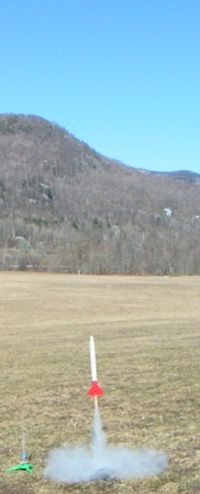
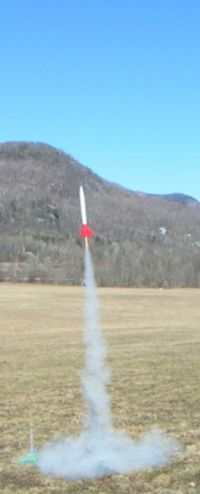
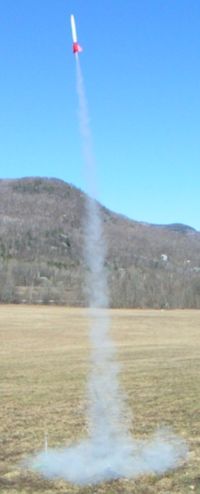
The recovery system looks great and looks like it will last a while.
For FLIGHT/RECOVERY, I would rate this rocket 4 ½ points. I'm very pleased with the performance of this rocket. And even though it will never fly on E9's, I think it is a nice rocket for C11's. I'm also looking forward to a D12 flight and then maybe I'll break out my 24mm RMS system for it! Perhaps, I'll change to a streamer first. The recovery system and rip-stop parachute are very nice. The only thing not making the rocket a perfect 5 is that if a rocket is designed for E9's, I think an adapter should come with it to allow flights on C11 and D12's. That's all. Perhaps, overly critical.
I give the rocket an OVERALL rating of 4 points. The rocket has classic lines which makes it look nice. It makes a nice addition to any fleet. It does take some patience in finishing with the all balsa nose cone. But the recovery system and the motor choice flexibility are nice. Remember the price comparison at the top of this review? Go get a Mighty Mick... but watch that motor mount assembly!
 |
 |
Flights
 |
 |